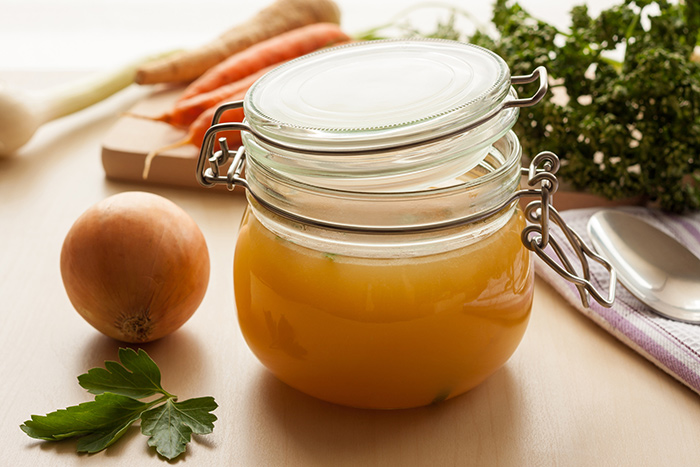
The Fountain of Youth.
The Elixir of Life.
Witches Brew.
Honestly, people talk about bone broth like it’s actual magic. No, this is not some, secret “liquid gold,” but there are a number of reasons why people are talking about it. It might not be as powerful as a “magic potion”, but hey, depending on what your body needs, bone broth is definately a “superfood”.
What is Bone Broth?
What exactly is it? You might be more familiar with chicken stock or beef stock — but let’s be very clear: broth and stock are technically different (more on that later!). Bone broth is a soup base that’s created by simmering bones in water for as long as 72 hours.
Don’t worry… the broth doesn’t have to be plain. You can add vegetables and seasoning without worrying about diluting any of the broth’s benefits. It’s also okay if some meat is still attached to the bone when you prepare your ingredients.
The key secret that makes bone broth different is the long cooking time. Simmering bone broth for over 24 hours allows the gelatin to be extracted from the bones. This process releases nutritious compounds and minerals such as calcium, collagen, amino acids and electrolytes.
Nutritional compounds that are said to be found in bone broth include glycosaminoglycans (good for digestive health), glucosamine (excellent for joint health), hyaluronic acid (great for anti-aging), and chondoitin sulfate (reduces inflammation and improves cardiovascular health).
Though bone broths are as old as the Stone Age, they’ve recently made a comeback as a health trend. It’s a staple of the Paleo diet and is heralded for potential benefits such as helping leaky gut syndrome, helping joints and promotes healthy hair, nails, and skin.
What’s particularly amazing is that bone broth packs all these health benefits and nutrients while being relatively low in calories. Bone broth won’t necessarily be a meal replacement, but you can add it to your everyday diet without feeling guilty.
So… What’s the Difference Between Bone Broth and Stock?
Some might argue that bone broth and stock are essentially the same thing. Well, yes… And no.
The long simmer time is one of the things that makes bone broths so unique. Regular broths and stocks don’t adhere to the same long simmer time.
The other main difference is taste. Your typical chicken stock and beef stock will be lighter, saltier and more flavorful. No wonder it’s a favorite when people have a cold or the flu! Compare this to bone broth, which will be much thicker because of the released colagen. Bone broth is also typically low on sodium and tastes more bland.
Bro Broth: High in Protein and Amino Acids
Bone broths are like the original protein shake. You can find 19 easy-to-absorb essential and non-essential amino acids in brone broth. And… if you’ll recall from your high school Biology class, these amino acids are the building blocks of protein.
You’ll find that most packaged bone broth that you’ll find in stores has 4 to 10 grams of protein per serving. This great news for anyone who is looking for a simple way to add more protein to their diet.
- Swanson’s Organic Freee Range Chicken Bone Broth – 9 grams per cup
- Pacific Foods Organic Chicken Bone Broth – 9 grams per cup
- Imagine Foods Chicken Bone Broth – 9 grams per cup
- Epic Savor Chicken Bone Broth – 10 grams per cup
Gut Health?
Did you know that collagen is the connective tissue in your gut? When you suffer from “leaky gut syndrome”, particles that are supposed to stay in your digestive tract accidentally pass into your bloodstream. This can lead to some unpleasant side effects such as inflamation.
Collagen production occurs naturally in our bodies. However, as we age, our bodies naturally produce less collagen, making our dietary choices richly important.
A research study of inflammatory bowel disease found that increasing intake of collagen could help repair and even build up the tissues that line your gastrointestinal tract. Because bone broth is rich with collagen, many people have made a connection and there are claims that it can help improve gut health.
There is NOT a lot of science to back up the claims related to gut health. When you injest collagen, the body turns it into amino acids…
Good for Hair, Skin, and Nail Health
The hyaluronic acid found in bone broth is known for its ability to contribute to cell proliferation, differentiation, and mitigation. This is why hyaluronic acid is found in so many anti-aging creams and supplements. It supports both cell rejuvenation and skim firmness, which promote a natural and healthy aging process.
When your body breaks down and absorbs collagen, it can contribute to the health of your skin, hair, and nails. (However, just like with gut health, you can’t control the way your body uses the collagen/amino acids you injest.)
Glycine, another nutrient found in bone broth, is linked to improved sleep quality. Quality sleep can reduce wrinkles and keep the bags under your eyes at bay.
Think about it: when you consume bone broth, you are consuming the exact nutrients that compose bones, joints, and the surrounding connective tissues. No wonder the benefit is so profound!
There is no one right way to consume bone broth. Some like to eat it like a soup or thick stew. Others like to use it to moisten dry food. Still, others drizzle it over rice or quinoa. Some just like to sip it as a warm, savory beverage. Whatever method you choose, you are sure to enjoy its benefits!
Here are some simple bone broth recipes:
- Slow Cooker Bone Broth
- How to make Homemade Bone Broth
- Tomato Basil Soup
- Easy Roasted Garlic Soup (omit the bread if you want to reduce calories)
- 5 Ingredient Meatball Soup
- Bone Broth Lentil Soup
- Lemon Ginger Bone Broth
- Vegetable Coconut Curry
- One Broth, 10 Soups – How to turn bone broth into 10 soups

Comment Via Facebook